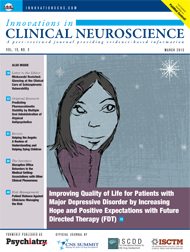 by Yuichiro Abe, MD, PhD; and Andrea Raballo, MD, PhD
by Yuichiro Abe, MD, PhD; and Andrea Raballo, MD, PhD
Dr. Abe is from Department of Psychophysiology, National Institute of Mental Health, National Center of Neurology and Psychiatry, Tokyo, Japan; and Dr. Raballo is from Department of Mental Health, Azienda Unitá Sanitaria Locale di Reggio Emilia, Reggio Emilia, Italy.
Innov Clin Neurosci. 2013;10(3):10–11
Funding/financial disclosures: No funding was received for the preparation of this article. The authors have no conflicts relevant to the content of this article.
Dear Editor:
More than 80 years after his famous monograph on schizophrenia,[1] some of the original intuitions of the French psychiatrist, born in Russia, Eugène Minkowski (1885–1972), seem to have regained proper appreciation in the field of continental psychopathology. This is the case for the clinical-phenomenological notions of “loss of vital contact with reality,” “morbid rationalism,” and “interrogative attitude,” which capture prototypical, encompassing features of schizophrenia that often antedate the emergence of behavioral symptoms (e.g., delusions, hallucinations, social withdrawal).[2,3] Similarly, on a more theoretical level, Minkowski coined the expression le trouble générateur, or generative disorder, to indicate the underlying core of patients’ manifest symptoms—that is, an organizing principle that transcends the single symptomatic expressions and lends a sort of morphogenetic coherence to the whole clinical picture.[2–4]
In Japan, for instance, such intuition was promptly echoed by Kimura who emphasized the complex genesis of schizophrenia and its irreducibility to the surface of behavioral manifestations.[5] Minkowski’s original expression le trouble générateur was rendered with ???? (kihon shogai; basic disturbances) in Japanese. However, this subtle phrasing conveys only parts of the semantic layers that are implicit in the French meaning. Indeed, the very notion refers to a psychopathological infrastructure—that is to say a kernel that underlies the manifest symptoms in all their variety, keeping them meaningfully interconnected in an interdependent and comprehensible way.[1]
In this sense, Minkowski’s notion still remains an inspiring source for the clinical and psychotherapeutic understanding of schizophrenic vulnerability.[2–4] In our view, this is even more pertinent since his intuitions seem to be a very natural outgrowth of his own daily clinical concerns: a constant effort to discern the essential nature of schizophrenia through the interaction with his own patients. Thus, through the unifying lens of the notion of “generative disorder,” which can be conceived as a formal, structural complexity bestowing a coherent meaning over the idiosyncratic expressions of the disorder, first, it may be easier to discern the unfolding of psychotic vulnerability despite its manifold manifestations; second, it might be possible to reintegrate the qualitative anomalies of subjective experiences that characterize schizophrenia into a shareable interpretative frame leading to such symptom formation; third, it might be possible to identify related schizophrenia spectrum vulnerability phenotypes that do not express flamboyant behavioral symptoms but nonetheless reflect prolonged psychobiographic trajectories stemming from the very same pathogenetic substrate (e.g., more or less compensated schizotypes).
We do not necessarily mean that the notion of “generative disorder” or le trouble générateur is only reduced to “neurologize” schizophrenia (i.e., it will be ascribed to one simple causal neural substrate for this disorder.).[3,4] Nevertheless, that might suggest the plausibility of the possible association between this and the recent neuroscientific findings about the thalamus/thalamic reticular nucleus dysfunctions in schizophrenia.[6] Hence, after three decades of tangible stagnation in the field of clinical psychopathology, which possibly reflect “unintended consequences” of DSM atheoretical empiricism,[7] rediscovering the body of Minkowski’s structural phenomenological works might once again inspire new generations of mental health professionals.
References
1. Minkowski E. La Schizophrènie: Psychopathologie des Schizoides et des Schizophrènes. Paris: Payot; 1927 (translated into Japanese by Masashi Murakami, 1954, revision 1988, Misuzu Shobo, Tokyo).
2. Stanghellini G. A hermeneutic framework for psychopathology. Psychopathology. 2010;43:319–326.
3. Urfer A. Phenomenology and psychopathology of schizophrenia: the views of Eugene Minkowski. Philos Psychiatry Psychol. 2001;8:279–289.
4. Ulfer-Parnas A, Mortensen EL, Parnas J. Core of schizophrenia: estrangement, dementia or neurocognitive disorder? Psychopathology. 2010;43:300–311.
5. Kimura B. Pathology of cogito in schizophrenia. Jpn J Psychopathology. 2010;31:147–154 (article in Japanese)
6. Ferrarelli F, Peterson MJ, Sarasso S, et al. Thalamic dysfunction in schizophrenia suggested by whole-night deficits in slow and fast spindles. Am J Psy. 2010;167:1339–1348.
7. Andreasen NC. DSM and the death of phenomenology in America: an example of unintended consequences. Schizophr Bull. 2007;33:108–112.


